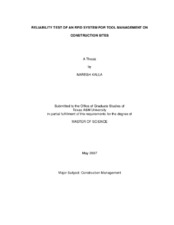| dc.description.abstract | In the construction industry, one of the aspects that affect the productivity
of the construction crew is the availability of tools and supplies. Unavailability of
tools and supplies results in a delay of the project, which in turn increases the
cost of the project. If any such delays on job sites could be reduced, it would
help the construction industry in reduction of time and cost losses. The
construction industry is in need of a technology that would improve the presentday
tool management system (TMS) to reduce the construction costs from
delays in projects.
Radio Frequency Identification (RFID) technology offers the possibility
that tools and supplies, tagged with RFID devices, could be tracked down
automatically. Although the potential of RFID is real, it does have limitations
like any other technology. Without understanding and working with the
limitations of RFID, this technology may disappoint many before its true and
significant capabilities are realized. Before the technology is executed fullfledged,
it needs to be tested for reliability on construction sites in particular.
Researchers, from many parts of the world, have performed tests to understand the reliability of the RFID technology considering variables like metal
interferences, reading range, multiple tag identification, etc. But these tests
conducted could not discuss all the factors that may affect the reliability of the
technology.
This paper identifies other factors that might affect the reliability of RFID
technology and tests are conducted to understand the influence of these factors
on the readability of the RFID tags. Number of tools and the velocity with which
tools are taken across the portal are two variables that are tested for reliability of
RFID. Tests are conducted using the experiment setup that resembles a
construction site tool management room entrance/exit.
Results show a radical decrease in the readability of tags, while the
numbers of the tools are increased gradually. And also, when the tools were
taken across the RFID portal with gradual increasing velocity, the readability
reduced. These results prove that both the tested parameters have an effect on
the reliability of RFID technology for tool tracking. | en |


